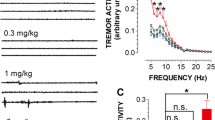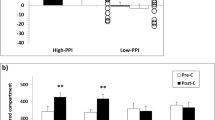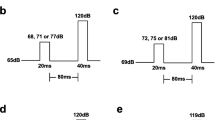Abstract
Rationale
3,4-Methylenedioxymethamphetamine (MDMA, ecstasy) is neurotoxic upon central serotonin systems in experimental animals and probably also in humans. Serotonin is involved in the habituation, sensitization and prepulse inhibition (PPI) of the startle reflex.
Objectives
To study the plasticity of startle reflex in currently abstinent MDMA users.
Methods
Electromyographic responses to acoustic startle stimuli (pulse alone and prepulse-pulse trials) were recorded in 23 currently abstinent ecstasy users and 20 matched control subjects. Depending on the extent of their previous drug use ecstasy users were divided into two groups [life-time dose <90 (n=11) and ≥90 pills (n=12), respectively].
Results
There were no significant differences in habituation, sensitization or PPI of the startle reflex between the entire group of ecstasy users and controls. However, sensitization of the startle reflex was stronger in the ≥90 compared with either the <90 MDMA pills or the control group. Correlations between patterns of drug use and startle parameters did not reach the level of significance, although users with a younger age at the onset of MDMA (and other drug) use tended to present with higher sensitization of the startle reflex.
Conclusions
Heavy users of MDMA (and other recreational drugs) present with strong sensitization of the startle reflex. Nevertheless, it is unclear whether this finding is secondary to the use of MDMA and its well-recognized neurotoxic potential. Alternatively, strong sensitization might reflect a pre-existing trait predisposing to drug use. A clearer picture of the impact of ecstasy on startle plasticity may be obtained from longitudinal investigations.

Similar content being viewed by others
References
Barrat ES (1985) Impulsiveness subtraits: arousal and information processing. In: Spence JT, Izard CE (eds) Motivation, emotion, and personality. Elsevier, North Holland, pp 137–146
Bhattachary S, Powell JH (2001) Recreational use of 3,4-methylenedioxymethamphetamine (MDMA) or “ecstasy”: evidence for cognitive impairment. Psychol Med 31:647–658
Bolla KI, McCann UD, Ricaurte GA (1998) Memory impairment in abstinent MDMA (“ecstasy”) users. Neurology 51:1532–1537
Braff DL, Grillon C, Geyer MA (1992) Gating and habituation of the startle reflex in schizophrenic patients. Arch Gen Psychiatry 49:206–215
Braff DL, Geyer MA, Light GA, Sprock J, Perry W, Cadenhead KS, Swerdlow NR (2001a) Impact of prepulse characteristics on the detection of sensorimotor gating deficits in schizophrenia. Schizophr Res 49:171–178
Braff DL, Geyer MA, Swerdlow NR (2001b) Human studies of prepulse inhibition of startle: normal subjects, patient groups, and pharmacological studies. Psychopharmacology 156:234–258
Burrell BD, Sahley CL (1999) Serotonin depletion does not prevent intrinsic sensitization in the leech. Learn Mem 6:509–520
Carrillo-de-la-Pena MT (1992) ERP augmenting/reducing and sensation seeking: a critical review. Int J Psychophysiol 12:211–220
Croft RJ, Klugman A, Baldeweg T, Gruzelier JH (2001) Electrophysiological evidence of serotonergic impairment in long-term MDMA (“ecstasy”) users. Am J Psychiatry 158:1687–1692
Daumann J, Fimm B, Willmes K, Thron A, Gouzoulis-Mayfrank E (2003) Cerebral activation in abstinent ecstasy (MDMA) users during a working memory task: a functional magnetic resonance imaging (fMRI) study. Cognit Brain Res16:479–487
Davis M, File SE (1984) Intrinsic and extrinsic mechanisms of habituation and sensitization: Implications for the design and analysis of experiments. In: Peeke HVS, Petrinovich LF (eds) Habituation, sensitization and behavior. Academic Press, New York, pp 287–323
Davis M, Heninger GR (1972) Comparison of response plasticity between the eyeblink and vertex potential in humans. Electroencephalogr Clin Neurophysiol 33:283–293
Davis M, Sheard MH (1976) p-Chloroamphetamine (PCA): acute and chronic effects on habituation and sensitization of the acoustic startle response in rats. Eur J Pharmacol 35:261–273
Duncan E, Madonick S, Chakravorty S, Parwani A, Szilagyi S, Efferen T, Gonzenbach S, Angrist B, Rotrosen J (2001) Effects of smoking on acoustic startle and prepulse inhibition in humans. Psychopharmacology 156:266–272
Ehrlich JS, Boulis NM, Karrer T, Sahley CL (1992) Differential effects of serotonin depletion on sensitization and dishabituation in the leech, Hirudo medicinalis. J Neurobiol 23:270–279
Filion DL, Dawson ME, Schell AM (1998) The psychological significance of human startle eyeblink modification: a review. Biol Psychol 47:1-43
Fischer C, Hatzidimitriou G, Wlos J, Katz J, Ricaurte G (1995) Reorganization of ascending 5-HT axon projections in animals previously exposed to the recreational drug (±)3,4-methylenedioxymethamphetamine (MDMA, “ecstasy”). J Neurosci 15:5476–5485
Geyer MA, Tapson GS (1988) Habituation of tactile startle is altered by drugs acting on serotonin-2 receptors. Neuropsychopharmacology 1:135–147
Geyer MA, Krebs-Thomson K, Braff DL, Swerdlow NR (2001) Pharmacological studies of prepulse inhibition models of sensorimotor gating deficits in schizophrenia: a decade in review. Psychopharmacology 156:117–154
Gouzoulis-Mayfrank E, Heekeren K, Thelen B, Lindenblatt H, Kovar KA, Sass H, Geyer MA (1998) Effects of the hallucinogen psilocybin on habituation and prepulse inhibition of the startle reflex in humans. Behav Pharmacol 9:561–566
Gouzoulis-Mayfrank E, Daumann J, Tuchtenhagen F, Pelz S, Becker S, Kunert HJ, Fimm B, Sass H (2000) Impaired cognitive performance in drug free users of recreational ecstasy (MDMA). J Neurol Neurosurg Psychiatry 68:719–725
Gouzoulis-Mayfrank E, Daumann J, Sass H (2002) [Chronic neurotoxic damage in ecstasy (MDMA) users. Review of the current state of research]. [German]. Nervenarzt 73:405–421
Gouzoulis-Mayfrank E, Thimm B, Rezk M, Hensen G, Daumann J (2003) Memory impairment suggests hippocampal dysfunction in abstinent ecstasy users. Prog Neuropsychopharmacol Biol Psychiatry (in press)
Groves PM, Thompson RF (1970) Habituation: a dual-process theory. Psychol Rev 77:419–450
Hatzidimitriou G, McCann UD, Ricaurte GA (1999) Altered serotonin innervation patterns in the forebrain of monkeys treated with (±)3,4-methylenedioxymethamphetamine seven years previously: factors influencing abnormal recovery. J Neurosci 19:5096–5107
Hawkins RD, Kandel ER, Siegelbaum SA (1993) Learning to modulate transmitter release: themes and variations in synaptic plasticity. Annu Rev Neurosci 16:625–665
Hegerl U, Juckel G (1993) Intensity dependence of auditory evoked potentials as an indicator of central serotonergic neurotransmission: a new hypothesis. Biol Psychiatry 33:173–187
Hegerl U, Gallinat J, Mrowinski D (1995) Sensory cortical processing and the biological basis of personality. Biol Psychiatry 37:467–472
Hutchison KE, Wood MD, Swift R (1999) Personality factors moderate subjective and psychophysiological responses to d-amphetamine in humans. Exp Clin Psychopharmacol 7:493–501
Kehne JH, Padich RA, McCloskey TC, Taylor VL, Schmidt CJ (1996) 5-HT modulation of auditory and visual sensorimotor gating: I. Effects of 5-HT releasers on sound and light prepulse inhibition in Wistar rats. Psychopharmacology 124:95–106
Koch M (1999) The neurobiology of startle. Prog Neurobiol 59:107–128
Krystal JH, Price LH, Opsahl C, Ricaurte GA, Heninger GR (1992) Chronic 3,4-methylenedioxymethamphetamine (MDMA) use: effects on mood and neuropsychological function? Am J Drug Alcohol Abuse 18:331–341
Kumari V, Checkley SA, Gray JA (1996) Effect of cigarette smoking on prepulse inhibition of the acoustic startle reflex in healthy male smokers. Psychopharmacology 128:54–60
Mansbach RS, Rovetti CC, Winston EN, Lowe JA, III (1996) Effects of the cannabinoid CB1 receptor antagonist SR141716A on the behavior of pigeons and rats. Psychopharmacology 124:315–322
Martin RS, Secchi RL, Sung E, Lemaire M, Bonhaus DW, Hedley LR, Lowe DA (2003) Effects of cannabinoid receptor ligands on psychosis-relevant behavior models in the rat. Psychopharmacology 165:128–135
Martinez DL, Geyer MA (1997) Characterization of the disruptions of prepulse inhibition and habituation of startle induced by alpha-ethyltryptamine. Neuropsychopharmacology 16:246–255
McCann UD, Szabo Z, Scheffel U, Dannals RF, Ricaurte GA (1998) Positron emission tomographic evidence of toxic effect of MDMA (“ecstasy”) on brain serotonin neurons in human beings. Lancet 352:1433–1437
McCann UD, Eligulashvili V, Ricaurte GA (2000) (±)3,4-Methylenedioxymethamphetamine (“ecstasy”)-induced serotonin neurotoxicity: clinical studies. Neuropsychobiology 42:11–16
Morgan MJ (1999) Memory deficits associated with recreational use of “ecstasy” (MDMA). Psychopharmacology 141:30–36
Ornitz EM, Guthrie D (1989) Long-term habituation and sensitization of the acoustic startle response in the normal adult human. Psychophysiology 26:166–173
Parrott AC, Lasky J (1998) Ecstasy (MDMA) effects upon mood and cognition: before, during and after a Saturday night dance. Psychopharmacology 139:261–268
Phillips MA, Oxtoby EK, Langley RW, Bradshaw CM, Szabadi E (2000) Effects of acute tryptophan depletion on prepulse inhibition of the acoustic startle (eyeblink) response and the N1/P2 auditory evoked response in man. J Psychopharmacol 14:258–265
Prinssen EP, Assie MB, Koek W, Kleven MS (2002) Depletion of 5-HT disrupts prepulse inhibition in rats: dependence on the magnitude of depletion, and reversal by a 5-HT precursor. Neuropsychopharmacology 26:340–347
Reneman L, Lavalaye J, Schmand B, de Wolff FA, van Den BW, den Heeten GJ, Booij J (2001) Cortical serotonin transporter density and verbal memory in individuals who stopped using 3,4-methylenedioxymethamphetamine (MDMA or “ecstasy”): preliminary findings. Arch Gen Psychiatry 58:901–906
Ricaurte GA, Martello AL, Katz JL, Martello MB (1992) Lasting effects of (±)-3,4-methylenedioxymethamphetamine (MDMA) on central serotonergic neurons in nonhuman primates: neurochemical observations. J Pharmacol Exp Ther 261:616–622
Ricaurte GA, Yuan J, McCann UD (2000) (+/-)3,4-Methylenedioxymethamphetamine (“ecstasy”)-induced serotonin neurotoxicity: studies in animals. Neuropsychobiology 42:5–10
Rodgers J (2000) Cognitive performance amongst recreational users of “ecstasy”. Psychopharmacology 151:19–24
Sipes TA, Geyer MA (1994) Multiple serotonin receptor subtypes modulate prepulse inhibition of the startle response in rats. Neuropharmacology 33:441–448
Sipes TA, Geyer MA (1995) 8-OH-DPAT disruption of prepulse inhibition in rats: reversal with (+)WAY 100,135 and localization of site of action. Psychopharmacology 117:41–48
Sipes TE, Geyer MA (1996) Functional behavioral homology between rat 5-HT1B and guinea pig 5-HT1D receptors in the modulation of prepulse inhibition of startle. Psychopharmacology 125:231–237
Swerdlow NR, Stephany N, Wasserman LC, Talledo J, Shoemaker J, Auerbach PP (2003) Amphetamine effects on prepulse inhibition across-species: replication and parametric extension. Neuropsychopharmacology 28:640–650
Thompson RF, Spencer WA (1966) Habituation: a model phenomenon for the study of neuronal substrates of behavior. Psychol Rev 73:16–43
Tuchtenhagen F, Daumann J, Norra C, Gobbele R, Becker S, Pelz S, Sass H, Buchner H, Gouzoulis-Mayfrank E (2000) High intensity dependence of auditory evoked dipole source activity indicates decreased serotonergic activity in abstinent ecstasy (MDMA) users. Neuropsychopharmacology 22:608–617
Vollenweider FX, Remensberger S, Hell D, Geyer MA (1999) Opposite effects of 3,4-methylenedioxymethamphetamine (MDMA) on sensorimotor gating in rats versus healthy humans. Psychopharmacology 143:365–372
Zakzanis KK, Young DA (2001) Memory impairment in abstinent MDMA (“ecstasy”) users: a longitudinal investigation. Neurology 56:966–969
Zuckerman M (1972) Drug usage as one manifestation of a “sensation-seeking” trait. In: Keup W (ed) Drug abuse: current concepts and research. Charles C. Thomas, Springfield, Ill., pp 154–163
Zuckerman M (1990) The psychophysiology of sensation seeking. J Person 8:313–345
Zuckerman M, Eysenck S, Eysenck HJ (1978) Sensation seeking in England and America: cross-cultural, age, and sex comparisons. J Consult Clin Psychol 46:139–149
Zuckerman M, Simons RF, Como PG (1988) Sensation seeking and stimulus intensity as modulators of cortical, cardiovascular, and electrodermal response: a cross-modality study. Person Indiv Diff 9:361–372
Acknowledgements
This work was supported by a grant of the German Research Foundation (Deutsche Forschungsgemeinschaft; DFG) to E. Gouzoulis-Mayfrank (DFG GO 717/4-1). The authors thank Bianca Till, Gernot Hensen and Bastian Thimm for their support in recruiting the participants of this study. M.A. Geyer has an equity interest in San Diego Instruments, Inc.
Author information
Authors and Affiliations
Corresponding author
Rights and permissions
About this article
Cite this article
Heekeren, K., Daumann, J., Geyer, M.A. et al. Plasticity of the acoustic startle reflex in currently abstinent ecstasy (MDMA) users. Psychopharmacology 173, 418–424 (2004). https://doi.org/10.1007/s00213-003-1729-y
Received:
Accepted:
Published:
Issue Date:
DOI: https://doi.org/10.1007/s00213-003-1729-y




